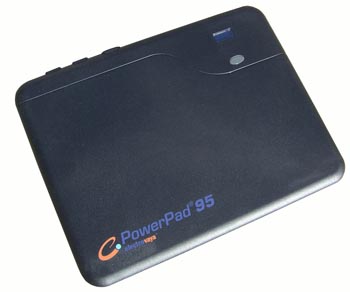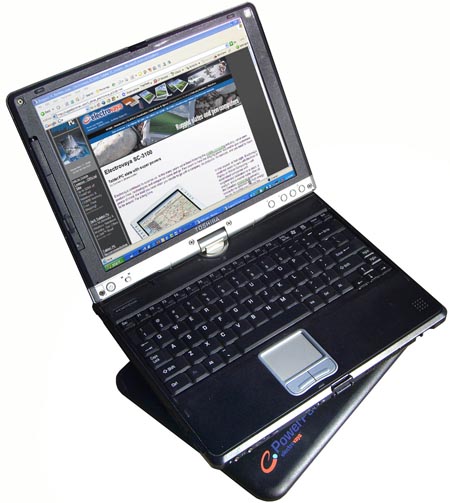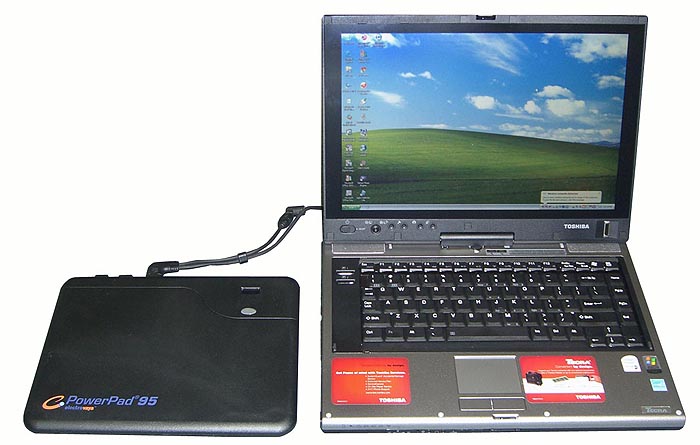 This is a review and description of Electrovaya's PowerPad 95 that provides your laptop with plenty of backup power and can even be used to charge other devices. At Pen Computing Magazine and RuggedPCReview.com we've been using older PowerPad models for years and practically couldn't live without them.
This is a review and description of Electrovaya's PowerPad 95 that provides your laptop with plenty of backup power and can even be used to charge other devices. At Pen Computing Magazine and RuggedPCReview.com we've been using older PowerPad models for years and practically couldn't live without them.
Let's face it, when it comes to battery power in our notebook computers, we're caught in sort of a technological catch-22. We want ever faster processors, ever more storage, ever larger displays, and we must have whatever latest technology can be added to a laptop. That all consumes a lot of power, as evidenced by how hot today's notebooks are running. Problem is we also want more battery life.
Can we have it all? Can we get that huge 15 or 17-inch display, the 300GB disk, the Core Duo processor, watch DVDs on the thing, listen to music, work all through an intercontinental flight, and so on? Not usually. Battery technology has come a long way, but whatever progress the battery guys make is usually soaked up immediately by the ever more powerhungry technology required to make all that speed and all those features possible.
In addition, while new notebooks usually perform rather well in the battery department, internal batteries tend to get tired quickly. Who doesn't have an older notebook that lasts an hour or less on a charge, and sometimes just minutes? Yes, it's a problem.
And one Electrovaya has the perfect solution for.
The PowerPad 95
The PowerPad 95 is the latest in Electrovaya's line of productivity enhancers in the form of exceedingly handy external battery modules that can double, triple, or quadruple the time you can work on your notebook. Like all PowerPads, the 95 is based on Electrovaya's patented SuperPolymer technology that combines the advantages of Lithium-Polymer technology (see discussion below) with the longest life possible.
And unlike conventional external battery or spare batteries, the PowerPads are handy, unobtrusive, slender slate-like pads that you tuck away underneath the computer (or even use as a mouse pad). The PowerPad 95 measures just 10.6 x 8.2 inches. That's barely half the footprint of today's larger notebooks, and less even than that of an ultra-light. Better yet, the 95 is just six tenth of an inch thick (see picture of backside below) and weighs not even two pounds. It stashes away easier than a paperback, yet when you need it, it's totally invaluable.

It's totally invaluable because the PowerPad 95 gives you backup power when your notebook's battery conks out. How much longer will it last? That depends on your notebook. Today's laptops come with batteries that pack as little as 20 watt-hours up to as much as 50 or 60 watt-hours. Well, the PowerPad 95 adds, surprise, another 95 watt-hours to that. You do the math.
How does it work and how do you use it?
Simple. You just plug the PowerPad's "Smart Tip" into your laptop's AC jack. The laptop then thinks it's on AC power and merrily goes about its business, drawing from the PowerPad instead of a standard AC adapter. Why is it called a "Smart Tip"? Because its pins allow the PowerPad to determine what output voltage your laptop or other device needs (the range can be from 5 Volts all the way to 24 Volts). 
If you're concerned whether the PowerPad 95 will work with your notebook due to the many different power connectors out there, chances are it will. Electrovaya has an online list of compatible machines (click for compatilbility list) and if yours is not on it, which is unlikely, you can contact Electrovaya for a solution. The picture to the right shows a Toshiba Portege 3500 Tablet PC convertible sitting on top of the PowerPad. As you can see, the PowerPad's footprint is smaller even than that of the very compact 4-pound Portege. And it provides nearly 2.5 times the power of the Portege's own 40 watt-hour battery!
The sideview picture above shows two USB ports. They let you connect and charge cellphones, Palms, Pocket PCs, Blackberries or whatever else can be charged via a standard USB port. Very handy.
The PowerPad 95's cable arrangement is such that the unit's adapter goes both to the notebook and to the PowerPad's own charger. This way you can charge the PowerPad while it provides juice to your laptop. Charging will take a bit longer that way, of course. And make sure you don't lose any of the adapters.
The PowerPad has a power on/off button that also lets you select and confirm output voltage options. Above it is a small LCM (Liquid Crystal Module) that shows the discharge voltage in orange and the battery charge both in percent and via a battery fuel gauge icon in blue. Also present is an "SOH" display. SOH stands for "State of Health." That's unique and an indicator of the overall status of the PowerPad's internal SuperPolymer modules which, like all batteries, will gradually decline after a few hundred charge cycles.
Early Lithium-Polymer batteries had a reputation for slow charging, and they still charge slower than standard Li-Ions. The PowerPad takes just over two hours to charge to 80% capacity, a more than satisfactory performance in most situations.
Electrovaya - the company and its technology
Electrovaya is one of our favorite companies. They are not huge like Microsoft or Sony or Apple, but their relentless pursuit of transforming innovation into tangible, useful products is unique and remarkable. Specifically, Electrovaya seeks to lessen the pain and frustration that comes with powering the ever-expanding number of electronic gadgets and products in our lives. Those products range from tiny cellphones to PDAs, computers all the way to vehicles and applications we haven't even thought of. Think about it: as a society we're dependent on power, and most of it we get from plugging things in. When we can't, we need batteries. And batteries are a pain because they don't last long enough.
That's why two young guys began researching battery technologies back in 1983. They started a company to research the potential of a variety of technologies. In 1996, that, in turn, led to another company dedicated to research, development, manufacturing and commercializing rechargeable, lithium ion polymer battery technology. The result of this research was the development of the now patented Lithium-Ion SuperPolymer battery technology.
Rechargeable Lithium-Ion batteries were introduced in the early 1990s. Their advantages are light weight, longer life, and slower discharge. I remember well how pleased we all were when those Li-Ion batteries became available in notebooks. In Lithium-Polymer technology, an evolution of the standard Lithium-Ion battery, conductive plastic is used to contain the lithium electrolyte instead of organic solvents. Plastic is lighter and much more easily shaped into all sorts of forms. As a result, Lithium-Polymer batteries don't need metal casings and thus can be flat sheets instead of the traditional bricks or rolls. Or many other shapes. That presents some manufacturing challenges, but is doable. Another advantage is that the polymer is a solid and not flammable like the liquids in standard Li-Ion cells.
Electrovaya took it all a step farther with its SuperPolymer Lithium Ion that is used in a variety of fields. As implemeted in products like the PowerPads, the batteries are shaped in the form of thin slates that sit under a notebook and can provide up to six times the power of a standard laptop battery. The PowerPad 120 and 160 have been available for several years, and Electrovaya now offers PowerPads with up to 300 watt-hours of capacity! The SuperPolymer process yields about 475 watt hours per liter, which translates into about 225 watt hours per kilogram and represents a very high energy density.
There are challenges as well, of course. Among them are longer charge times. However, Electrovaya has been in this game longer than most, and also has significant practical experience, including a contract with NASA where Electrovaya was given the task of providing its SuperPolymer technology as a power source for the spacesuits astronauts wear during spacewalks. Electrovaya also demonstrated the utility and performance of its battery technology in zero-emission electric vehicles where the Maya-100 test vehicle won several technology awards (yes, it beat the Toyota Prius for one of those awards).
Physics refresher
Because I think it's important to understand how it all fits together, let's deviate a bit into highschool physics. Remember how amperes, or amps, are a measure of electrical current, volt is a measure of electrical potential, and that when you multiply amps by volts you get watts, a measure that represents the power generated? Based on this there are other concepts:
An amp hour is a measure for a battery's storage capacity and is computed as the current in amperes multiplied by the hours it takes to discharge. For example, if you can draw 10 amps for eight hours, the battery would be said to have a storage capacity of 80 amp hours.
A watt-hour is the electrical energy equivalent to one watt being drawn for one hour. In our spec tables we often show a notebook batteries watt-hour capacity instead of just its amps as that alone is meaningless.
Energy density is the amount of energy stored. It is usually expressed in watt hours per kilogram or watt hours per liter. Note that the two are not the same as the specific weight of materials used determines the weight of one liter. In Lithium-Ion technology, 100 watt hours per kilogram amount to about 200 watt hours per liter.
What does all this mean?
Well, when you're dealing with computers, it means you can figure out how long your laptop is going to run on a charge. For example, when I take out the battery of the Toshiba Tecra M7 we have in our lab right now, the label shows that the battery is rated at 10.8V and 4,700 mAh. Multiply that and you get just over 50 watt-hours. The battery life of the Tecra M7, measured by MobileMark, is four hours. Our M7 gets that most of the time, which is remarkable, but sometimes still not enough.

Now spend an extra $199 for a PowerPad 95, and you're buying insurance in the form of twice the battery power of the Tecra's internal battery. Instead of a maximum of four hours, you're now looking at three times that. That is a huge difference. Why not simply buy a second battery for the notebook? Well, they are quite expensive. A second battery for the Tecra lists for US$119 and it is not nearly as convenient as the PowerPad. And the picture above shows just how small and handy the PowerPad 95 is compared to even a fairly compact notebook like the Tecra M7.
Bottomline
We love Electrovaya's PowerPads. There is nothing better to provide very significant extra battery life in slender, handy packages. The new PowerPad 95 will provide double or triple the battery of most internal batteries, it doesn't get hot, it lets you charge additional small devices via its two USB ports, and it fits anywhere. A clear Editor's Choice. Don't leave home without one.
Check the PowerPad 95 out at Electrovaya. -- C. H. Blickenstorfer



